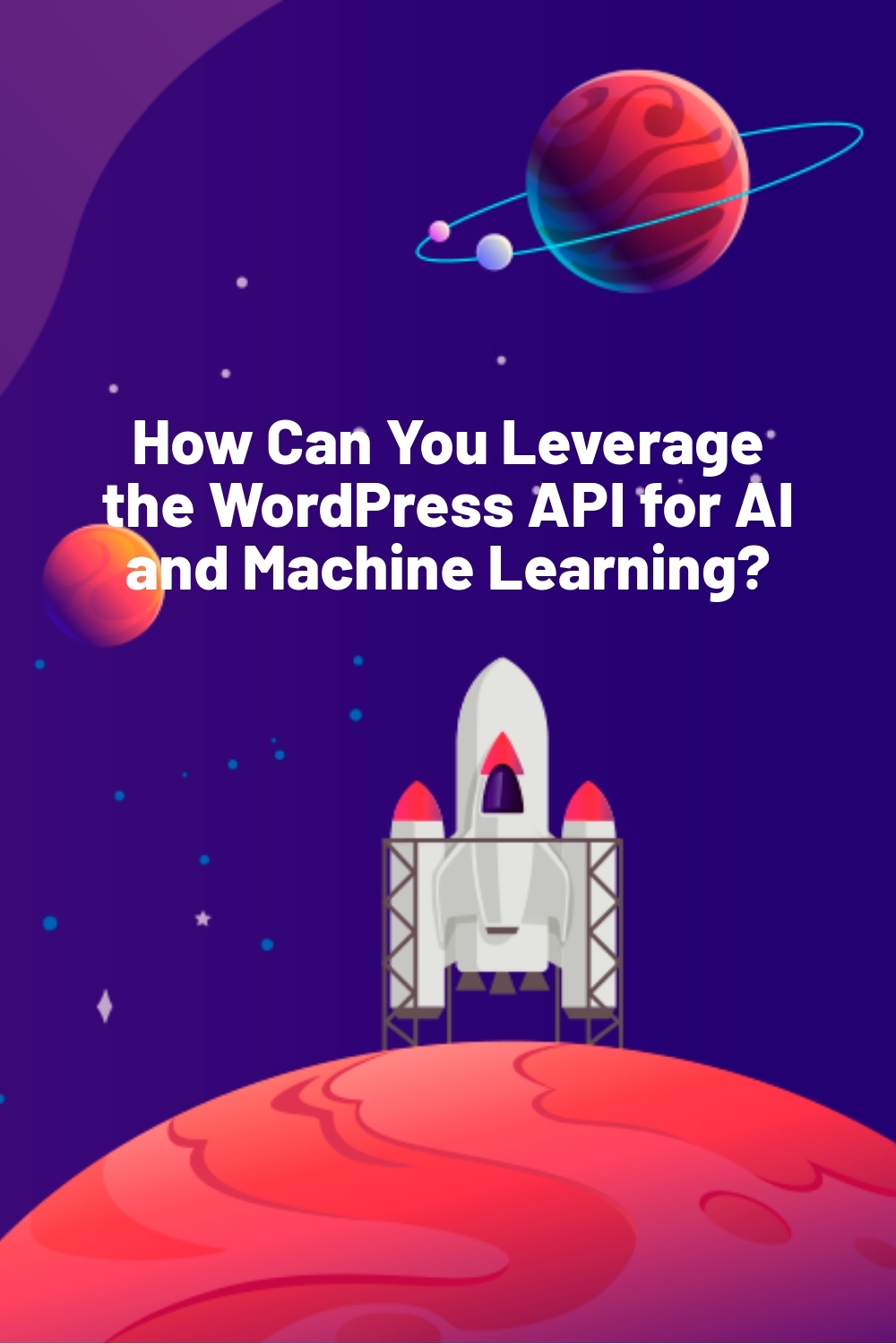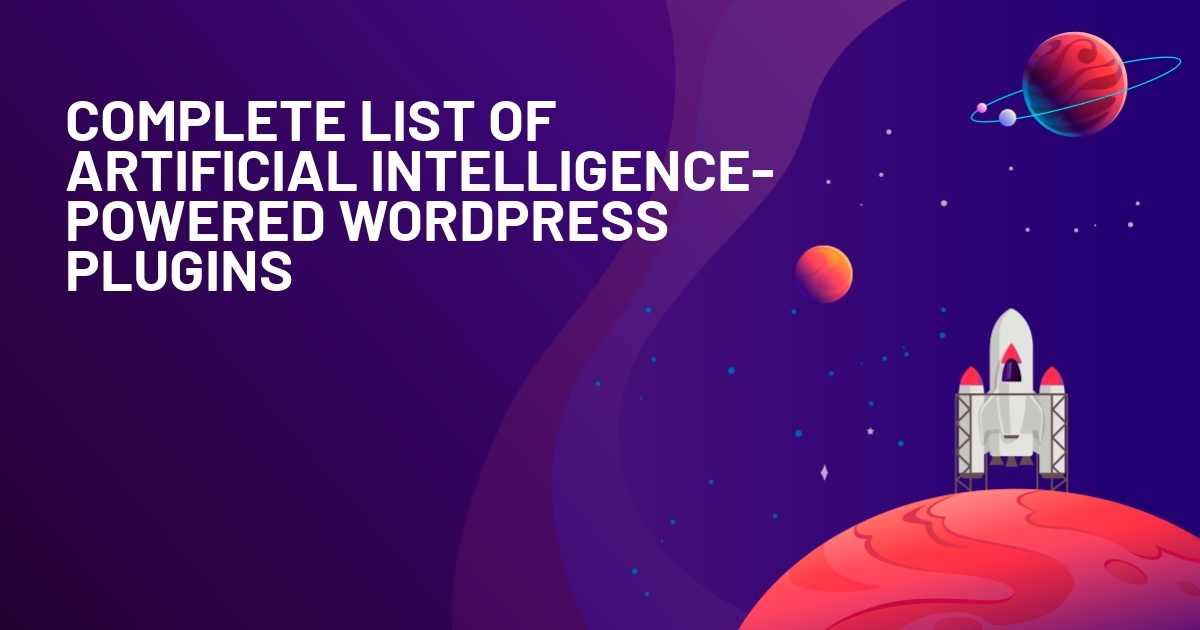WPLift is supported by its audience. When you purchase through links on our site, we may earn an affiliate commission.
How Can You Leverage the WordPress API for AI and Machine Learning?
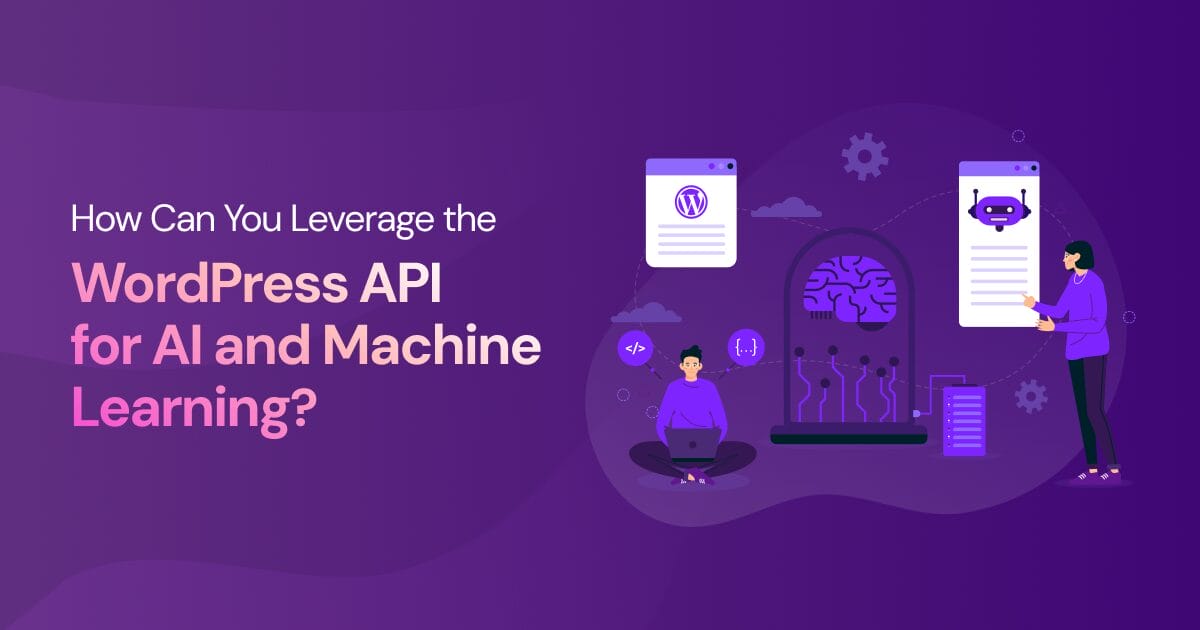
Have you ever visited a website that felt like it understood you? Maybe it suggested articles you actually wanted to read or offered products that caught your eye. This kind of smart experience is possible with AI and machine learning, and you can bring it to your WordPress site using the WordPress API.
It’s no secret that Artificial Intelligence (AI) and machine learning (ML) has been a game-changer right across the board, but did you know that using AI in WordPress can completely transform the way you do everything from designing layouts to creating content?
In this guide, we show you how you can leverage the WordPress API for machine learning to optimize the way you run your site and the kind of user experience you deliver.
What is WordPress API?
API stands for Application Programming Interface and describes a set of rules and protocols that allow different software applications to communicate with each other.
In 2016, WordPress version 4.7 introduced the REST (REpresentational State Transfer) API which connects your site with third-party applications and plugins, allowing them to interact with one another to expand the functionality of the default core platform.
It’s this API that, for example, allows you to integrate external software into your site to handle things like eCommerce order processing and email marketing.
The benefits of this are numerous:
- Extended functionality – The WordPress API can be harnessed to develop custom plugins that use WordPress data to develop interactive website elements for your users and improve your back-end management.
- App Development – If you’re developing a mobile app for your brand, you can use the REST API to allow visitors to interact with your site through that app.
- Flexibility – Ultimately, it opens up a whole new world of possibilities for the way you grow your website. You’re not limited to a single set of features or tools. As long as an application can leverage the API, you can bring it into your WordPress environment to meet the unique needs of your site and its visitors.
What is Machine Learning?
Machine learning is a specific type of AI that enables systems such as the WordPress CMS to learn and improve without relying on specific coding instructions.
This is made possible via the use of algorithms, which are trained on enormous amounts of data to become capable of identifying patterns and making predictions.
For example, software developers may use machine learning algorithms to identify objects in images or categorize user behavior on a website.
The Benefits of AI and ML for WordPress
Now that you know what machine learning is, you can probably begin to imagine the endless possibilities of using this type of AI in WordPress websites.
Whether your role is content-orientated or focused on behind-the-scenes management, you can put AI to work in improving what you do by:
Enhancing Personalization
There’s a reason 95% of marketers and executives believe in the value of personalization:
It works.
Globally-recognized business growth specialists McKinsey noted that personalization can improve revenues by as much as 15% and reduce customer acquisition costs by as much as 50%.
Integrating AI machine learning with the WordPress API provides an easy opportunity to deliver optimized personalized experiences to your visitors.
Its pattern-detecting capabilities can analyze a user’s behavior. AI can then turn the data produced from that analysis into an experience tailored to the user’s preferences.
For example, if you run an eCommerce store, your customers could be served with product recommendations that reflect their search and purchase history. Meanwhile, bloggers and news sites can use machine learning to provide tailored content suggestions.
Optimizing Content and Content Creation
Over the past year, we’ve witnessed the growth of a number of leading WordPress AI tools.
This is hardly surprising when you consider what these tools can do for busy site owners.
By harnessing the power of machine learning, platforms like AI Power provide generative AI capabilities that can produce blog post suggestions, titles, outlines, and even images.
Meanwhile, AI is also beginning to play an increasingly important role in WordPress SEO plugins such as Yoast and All in One SEO. These popular tools use it to recommend everything from SEO keywords to internal links, all with the goal of helping you improve your site’s performance in search results.
Improving Search
One common use of AI in WordPress is improving the in-site search functionality. By identifying patterns in user journeys and behaviors, AI-powered smart search can be used to provide more accurate and relevant results tailored to a user’s preferences.
For example, when an eCommerce customer searches for “jean skirt,” the AI will understand that this is similar to “denim skirt” and present relevant products. This helps you provide more options to your customers and increase the likelihood of a sale without keyword stuffing the daylights out of each product with every possible keyword.
Tightening Security
Arguably the most crucial benefit of AI and machine learning is that it can be used to improve your WordPress security.
Machine learning can be used to identify spam, concerning user behavior and other potential threats, and trigger the process to remove them before they become a problem.
Step-by-Step Guide to Implementing Machine Learning in WordPress
Integrating AI machine learning with the WordPress API can be accomplished in just a few simple steps:
1. Set Up Your WordPress Site
If you don’t already have web hosting, use our guide to the best WordPress hosting company to find one that suits your needs and budget.
In this example, we’ll be using Hostinger.
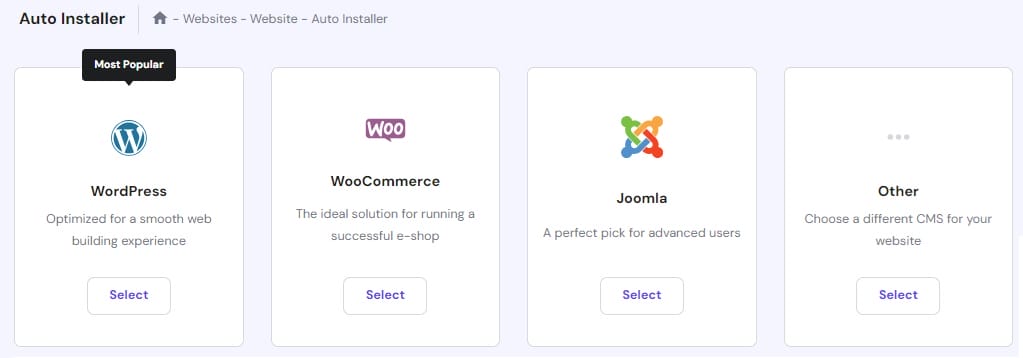
Use your hosting dashboard to navigate to the one-click installation options and select WordPress.
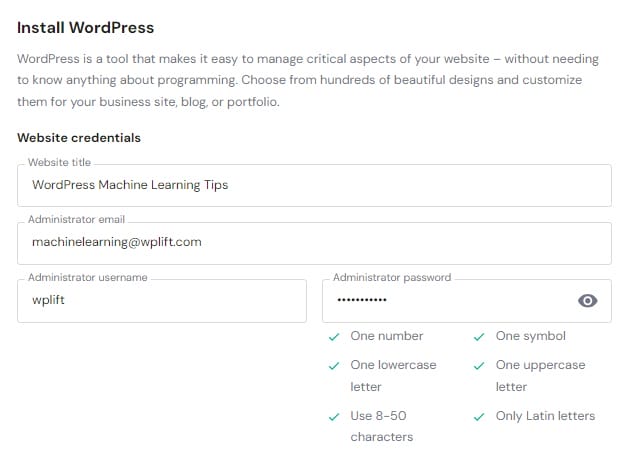
Next, enter your website credentials. This will trigger a quick and effortless process that adds the default WordPress installation on your server.
2. Choose a Machine Learning API
Next, it’s time to select a machine learning API suitable for the particular task you have in mind.
Think about your goals and objectives. What is it you want AI to do for you?
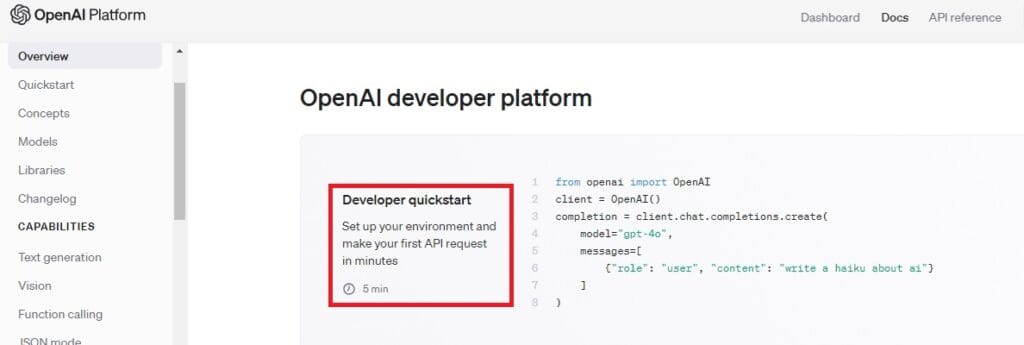
If it’s using image recognition to automatically categorize product images or detect faces in user-submitted photos, for example, then Google Vision API may be the best fit, whereas those of you focused on content generation may want to instead opt for the popular OpenAI API.
Other options include:
- SageMaker – a machine learning service from Amazon Web Services that can be used to train and implement large-scale machine learning models.
- Azure AI Services – Microsoft’s platform for creating customizable APIs and AI applications.
- TensorFlow – Another machine learning platform developed by Google that powers many of its products including Gmail, YouTube, and even search itself.
3. Get Your API Key
To get your ML API talking to your WordPress REST API, you’ll need to use an API key that acts as a unique identifier for your application. The route to accessing this key will depend on the API service you’re using.
Given its status as one of the most popular AI developer platforms in the world, we’ll focus our example on using OpenAI API.

To begin, point your browser to https://openai.com/index/openai-api and either sign in or create an account.
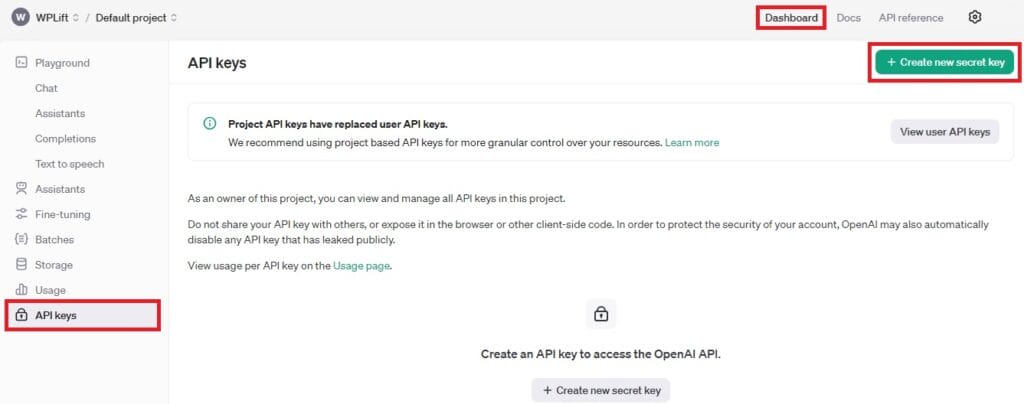
Next, Navigate to Dashboard – API Keys and click + Create new secret key.
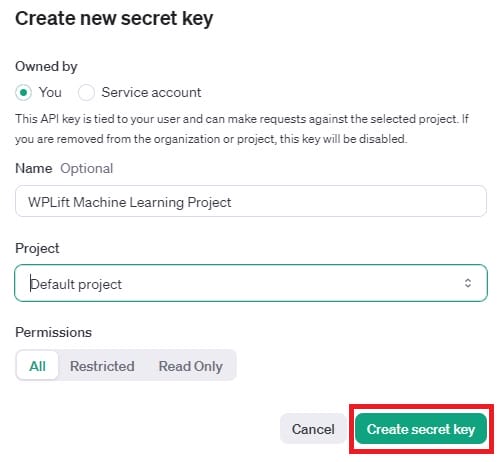
Give your key a name and click Create secret key.

This will generate a new key. It’s worth paying close attention to the fact that if you lose this key, you won’t be able to see it in your OpenAI account, so tap *copy* and be sure to save it somewhere safe.
4. Gather Your Data and Train Your Machine Learning Model
Before you set about implementing your WordPress machine learning setup, there’s one last thing to prepare:
Your data.
Export any data relevant to the task at hand (such as user behavior or content metrics) and take the time to eliminate errors and irrelevant information. This will make the data much better suited to training your machine language model.
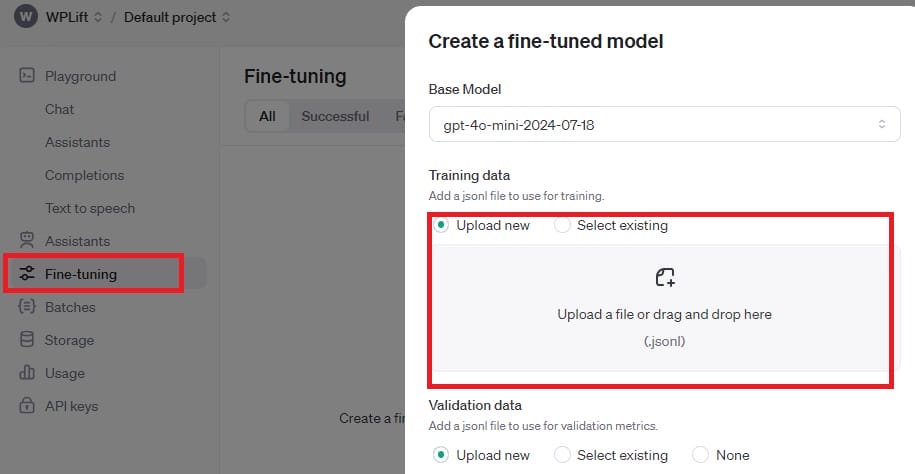
In OpenAI, you can upload this training data by going to Playground – Fine-tuning and uploading it as a .jsonl file.
Although you can use some pre-trained models such as GPT-4, some unique, site-specific tasks may require you to train a custom model.
5. Create a Custom WordPress API Endpoint
The most common way to create a custom endpoint in WordPress is to utilize the rest_api_init action hook and the register_rest_route function.
First, set a unique endpoint URL.
For content generation, this might be:
/wp-json/myplugin/v1/generate
Or it might be /wp-json/myplugin/v1/recommendations for content recommendation.
Next, define a callback function to process incoming data such as text prompts, and use the machine learning API you selected to send that processed data to your model.
Finally, format and return the model’s output as a JSON response.
When you’re done, you should have a code snippet that looks something like the below example for generating content based on an inputted keyword.
function generate_content_endpoint() {
register_rest_route( 'myplugin/v1', '/generate', array(
'methods' => WP_REST_Server::CREATABLE,
'callback' => 'generate_content_callback',
) );
}
add_action( 'rest_api_init', 'generate_content_endpoint' );
function generate_content_callback( WP_REST_Request $request ) {
// Retrieve keyword from the request
$keyword = $request->get_param('keyword');
// Send keyword to ML model (replace with your ML API integration)
$generated_content = generate_content_using_ml($keyword);
return new WP_REST_Response( $generated_content, 200 );
}You can add this code to your website by either creating a custom plugin for it or adding it to your functions.php file like so:
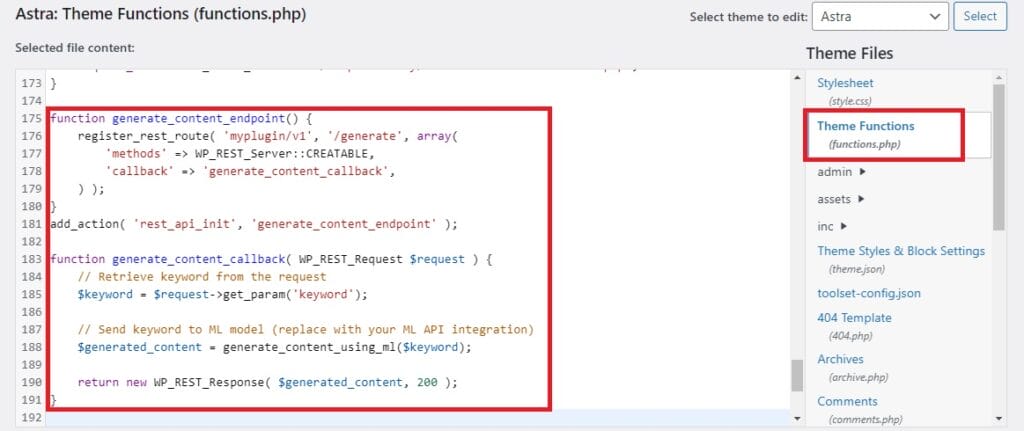
6. Test, Tweak, and Test Again
Finally, it’s important to test out your new machine learning WordPress integration to ensure everything works as it should.
Look at:
- Quality and relevance of returned results
- Response time and impact on website performance
- Errors.
Based on your testing, make any necessary tweaks and test again so that you’re confident you can use machine learning in your WordPress website with ease.
Best Practices for Utilizing Machine Learning in WordPress
While the technical aspect is fairly straightforward, there’s more to integrating AI than adding a few lines of code.
As you work through the integration process, it’s also crucial to adhere to the following best practices.
Data Privacy and Security
Failing to protect your user data can have a hugely detrimental impact on your site.
With that in mind, be sure to:
- Only collect data that is absolutely necessary for the task you need AI to complete
- Use anonymous or pseudonymized data where possible
- Encrypt sensitive data to prevent it from falling into the wrong hands
- Ensure you’re compliant with relevant data protection regulations such as GDPR and CCPA.
Optimizing Performance
Enhancing your website with machine learning isn’t going to do you much good if it drags down your overall site performance.
As such, you should:
- Run site load tests to identify performance issues
- Use caching to reduce API calls and boost response times
- Consider upgrading your server resources to handle the intensive process of using machine learning
- Continually monitor and optimize for performance.
Continuous Learning and Improvement
Working with machine learning is not a one-and-done process. You can improve the way it works in your WordPress site by:
- Carrying out further model training with new data on a regular basis
- Running A/B tests with different models and APIs
- Incorporating user feedback to further fine-tune your model.
Future of AI in WordPress
AI may seem like it has been firmly entrenched in the modern zeitgeist for some time now, but its use within the WordPress ecosystem is still relatively new.
As things continue to evolve, we confidently predict that AI elements such as machine learning will become ever more integral to the way we build, manage, and grow our WordPress sites.
In particular, we expect to see:
AI-Powered Web Design
We’ve already seen top WordPress page builders like Elementor give their users the ability to generate custom container layouts, but this really feels like it’s only the beginning of a greater push towards AI WordPress design.
Going forward, expect to see generative AI used to create entire themes and page designs based on user preferences.
Personalization by Design and Default
While personalization continues to play an increasing role in user experiences, it still feels very much like an added enhancement right now.
As AI tools become more and more accessible, you should start to see user personalization being built into the very foundation of your website.
For example, it wouldn’t be much of a surprise for eCommerce solutions to offer more accurate, personalized product recommendations as a standard, using machine learning to understand a customer’s preferences based on browsing history, personal data, or even external factors such as the weather.
Improved Insights and Analytics
Natural Language Processing (NLP) is a type of artificial intelligence focused on understanding human language in the context of interactions between users and applications.
We’re already seeing this used in sentiment analysis tools like Watsonfinds, which analyze your content to predict the kind of emotions audiences may feel as they read it.
That’s a good start, but the room for expanding sentiment analysis capabilities in WordPress is significant.
The opportunity exists to build NLP into analytics tools and use it to provide valuable insights into customer reviews, feedback form responses, and other types of user-generated content.
Enhanced Security
From generating malware to creating spam bots, one of the few drawbacks of AI, as it pertains to WordPress, is that cybercriminals will find ever more sophisticated ways to use it for nefarious purposes.
On the plus side, white hat developers will continue to explore new, more effective ways to harness AI machine learning in the fight against cybercrime.
As we move forward, this AI battle between offense and defense is likely to dominate the world of cybersecurity, both for WordPress and the web as a whole.
It will play a prominent role in the development of new security protocols and be an integral, fundamental force behind leading security plugins.
Leverage the WordPress API for AI and Machine Learning: Final Thoughts
If there’s one thing for certain, it’s that Artificial Intelligence and machine learning aren’t going anywhere and their impact on the way we run our websites will only become greater.
Whether it’s improving personalization and creating AI-powered designs or for back-end purposes like security and analytics, the number of WordPress AI plugins will undoubtedly grow.
Yet that doesn’t mean you have to use a pre-existing solution. The platform’s unique flexibility means that you can use the WordPress API in conjunction with machine learning to create all kinds of custom functionality.
For further reading, see the additional resources below:
Additional Resources
- WPLift’s Guide to the WordPress REST API
- WordPress REST API Handbook
- WordPress.com Developer Resources – REST API Documentation
- OpenAI API Documentation
- Google Cloud Vision API
Frequently Asked Questions
Do I need programming knowledge to integrate machine learning into WordPress?
Not necessarily. While it’s helpful to have some experience with PHP and the WordPress REST API, there are plugins and tutorials such as the one in our guide that simplify the process.
What is the best machine learning model to use with WordPress?
The best machine learning model is the one that best suits your needs and the needs of your WordPress website visitors. The objective you want to achieve and the resources you’ll need will ultimately play a deciding factor.
What are the potential challenges of integrating machine learning into a WordPress website?
Maintaining data quality and privacy are among the biggest challenges of using machine learning in WordPress, though the impact on your site performance may be something you’ll also need to look at.
